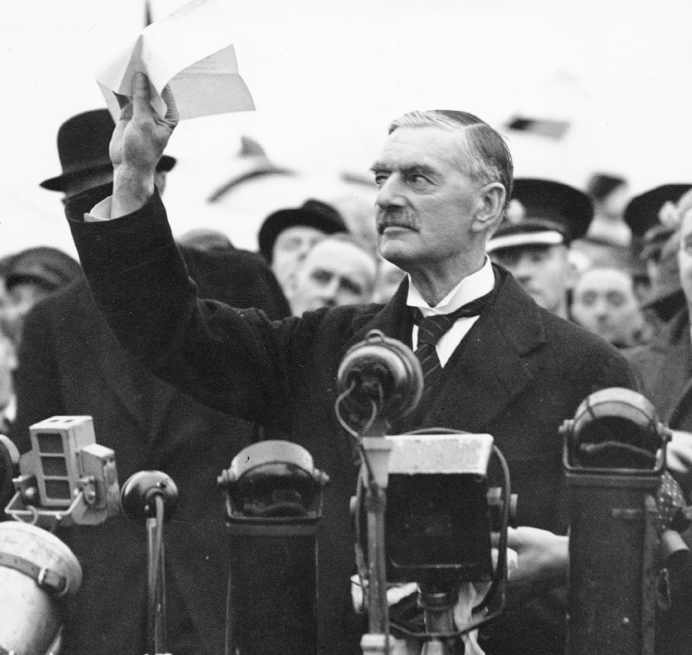Aggression and Appeasement
At the same time that they built the “people’s community,” the Nazis aggressively pursued policies meant to achieve territorial expansion for the supposedly superior German race. At first, Hitler carefully camouflaged his expansionist goals because Germany was still militarily weak. Germany’s withdrawal from the League of Nations in October 1933, however, indicated that Gustav Stresemann’s policy of peaceful cooperation was dead (see "Germany and the Western Powers" in Chapter 26). Then, in March 1935, Hitler declared that Germany would no longer abide by the disarmament clauses of the Treaty of Versailles. He established a military draft and began to build up the German army. France and Great Britain protested strongly and warned against future aggressive actions.
Any hope of a united front against Hitler quickly collapsed. Britain adopted a policy of appeasement, granting Hitler everything he could reasonably want (and more) to avoid war. British appeasement was motivated in large part by the pacifism of a population still horrified by the memory of the First World War. As in Germany, many powerful conservatives in Britain underestimated Hitler. They believed that Soviet communism was the real danger and that Hitler could be used to stop it.

When Hitler suddenly marched his armies into the demilitarized Rhineland in March 1936, violating the treaties of Versailles and Locarno (Map 27.2), Britain refused to act. France could do little without British support. Emboldened, Hitler moved ever more aggressively, enlisting powerful allies in international affairs. Italy and Germany established the so-

In late 1937 Hitler moved forward with plans to seize Austria and Czechoslovakia. By threatening Austria with invasion, Hitler forced the Austrian chancellor to put local Nazis in control of the government in March 1938. The next day, in the Anschluss (annexation), German armies moved in unopposed, and Austria became two provinces of Greater Germany.
Simultaneously, Hitler demanded that territories inhabited mostly by ethnic Germans in western Czechoslovakia — the Sudetenland — be ceded to Nazi Germany. Though Czechoslovakia was allied with France and the Soviet Union and prepared to defend itself, appeasement triumphed again. In negotiations, British Prime Minister Arthur Neville Chamberlain and the French agreed with Hitler that Germany should immediately take over the Sudetenland. Returning to London from the Munich Conference in September 1938, Chamberlain told cheering crowds that he had secured “peace with honor.” Chamberlain’s peace was short-
In August 1939, in an about-
For Hitler, everything was now set. On September 1, 1939, German armies and warplanes smashed into Poland from three sides. Two days later, Britain and France declared war on Germany. The Second World War had begun.
>QUICK REVIEW
What role did the ideas of “race” and “space” play in Hitler’s ideology? How did they shape Nazi policies?